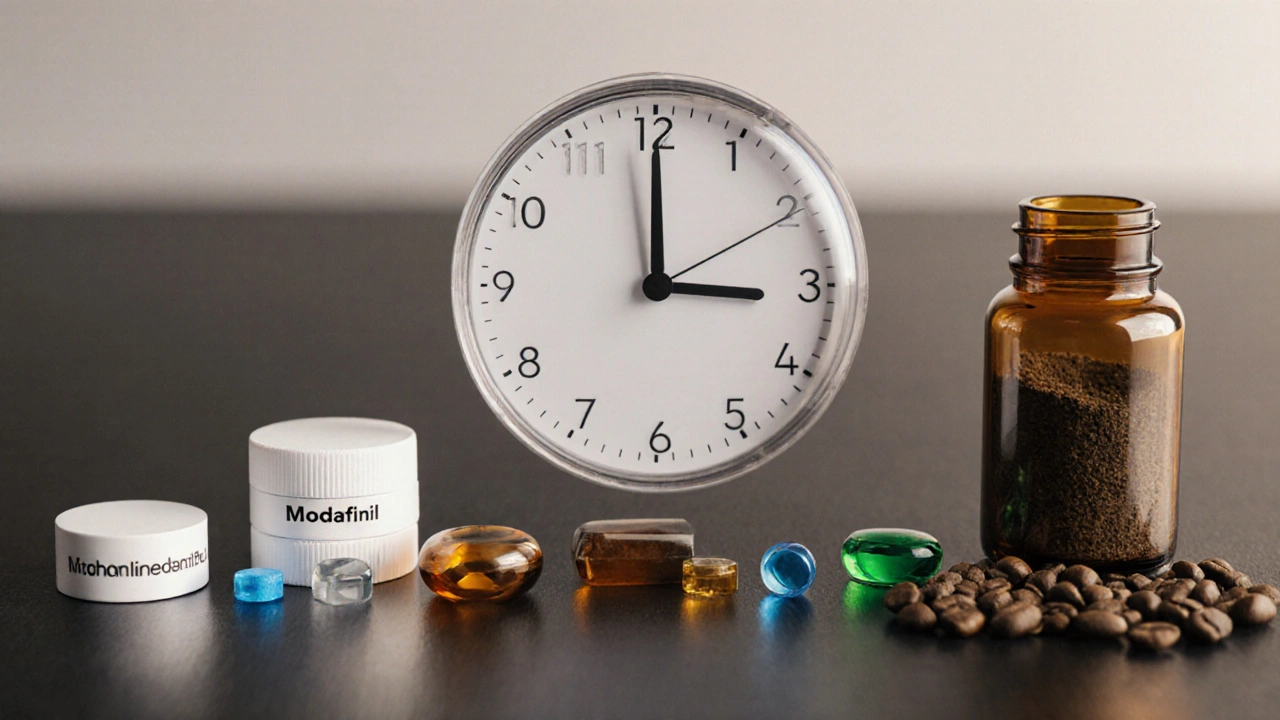Modafinil vs Alternatives: Drug Comparison Tool
This tool compares key characteristics of various wake-promoting agents to help you understand their differences.
Drug Comparison Table
| Attribute | Selected Drug | Comparison Drug |
|---|---|---|
| Legal Status | - | - |
| Primary Mechanism | - | - |
| Onset Time | - | - |
| Duration | - | - |
| Typical Dose | - | - |
| Common Side Effects | - | - |
Drug Details
Best For
Select a drug to see usage recommendations.
Important Notes
Select a drug to see safety information.
Did you know a single dose of a wake‑promoting drug can keep you alert for up to 15 hours? That power comes from a handful of compounds that tweak the brain’s chemistry in similar but distinct ways. If you’re hunting for a reliable boost-whether for shift work, study marathons, or occasional jet‑lag-understanding how modafinil stacks up against its peers is crucial.
Quick Takeaways
- Modafinil offers the longest typical duration (12‑15hrs) with a relatively mild side‑effect profile.
- Armodafinil is the R‑enantiomer of modafinil; it lasts a bit longer and may work better for late‑night users.
- Adrafinil is a pro‑drug you can buy over the counter, but it puts extra strain on the liver.
- Stimulants like methylphenidate (Ritalin) and lisdexamfetamine (Vyvanse) act faster but carry higher abuse potential.
- Newer agents such as pitolisant and solriamfetol target different receptors and may suit people who can’t tolerate classic stimulants.
Defining the Players
Modafinil is a prescription‑only wakefulness‑promoting agent that was first approved in the United States in 1998. It works primarily by inhibiting dopamine reuptake, which nudges the brain’s reward pathways without causing the intense euphoria of classic stimulants. Marketed under brand names like Provigil and the NewZealand‑specific Modafil MD, it’s commonly used to treat narcolepsy, shift‑work sleep disorder, and obstructive sleep apnea‑related fatigue.
Armodafinil is the pharmacologically active R‑enantiomer of modafinil. Because it contains only the more potent half of the molecule, patients often report a slightly longer duration of alertness (up to 16hrs) and a smoother “come‑down.” It’s sold under the name Nuvigil.
Adrafinil is a pro‑drug that the liver converts into modafinil. It’s available as an over‑the‑counter supplement in many countries, which makes it attractive for casual users. The conversion process, however, can stress hepatic enzymes, so regular liver function monitoring is advisable.
Methylphenidate, better known by its brand name Ritalin, is a central nervous system stimulant that blocks dopamine and norepinephrine reuptake. It takes effect within 30‑60minutes and lasts 3‑5hours, making it useful for short bursts of focus but less ideal for all‑day wakefulness.
Lisdexamfetamine (Vyvanse) is a pro‑drug amphetamine that converts to dextro‑amphetamine in the bloodstream. Its onset is slower (about 1‑2hours) but the effect can linger for 10‑12hours, offering a middle ground between classic stimulants and modafinil‑type agents.
Pitolisant is a histamine‑H3 receptor antagonist approved in Europe for narcolepsy. By boosting natural histamine release, it promotes wakefulness without directly affecting dopamine, which may reduce typical stimulant side effects.
Solriamfetol (Sunosi) is a newer dopamine‑norepinephrine reuptake inhibitor that received FDA approval in 2019 for excessive daytime sleepiness. It provides a rapid onset (≈30minutes) and a duration of 6‑8hours.
Caffeine remains the world’s most widely consumed psychoactive substance. While it works through adenosine antagonism and can improve alertness for 3‑5hours, tolerance builds quickly, and high doses lead to jitteriness.

How the Drugs Compare
| Ingredient | Legal Status | Primary Mechanism | Onset | Duration | Typical Dose | Common Side Effects |
|---|---|---|---|---|---|---|
| Modafinil | Prescription | Dopamine reuptake inhibition | 30‑60min | 12‑15hr | 200mg once daily | Headache, nausea, insomnia |
| Armodafinil | Prescription | R‑enantiomer dopamine inhibition | 45‑60min | 14‑16hr | 150mg once daily | Dry mouth, dizziness, anxiety |
| Adrafinil | OTC (supplement) | Pro‑drug to modafinil | 60‑90min | 12‑14hr | 300mg once daily | Liver enzyme elevation, insomnia |
| Methylphenidate (Ritalin) | Prescription | Dopamine & norepinephrine reuptake inhibition | 30‑45min | 3‑5hr | 10‑60mg oral | Appetite loss, tachycardia, anxiety |
| Lisdexamfetamine (Vyvanse) | Prescription | Pro‑drug amphetamine | 1‑2hr | 10‑12hr | 30‑70mg oral | Insomnia, dry mouth, irritability |
| Pitolisant | Prescription (EU) | Histamine‑H3 antagonism | 45‑60min | 8‑10hr | 10‑40mg oral | Insomnia, headache, nausea |
| Solriamfetol | Prescription (US) | Dopamine‑norepinephrine reuptake inhibition | ≈30min | 6‑8hr | 37.5‑150mg oral | Decreased appetite, anxiety, insomnia |
| Caffeine | OTC | Adenosine receptor antagonism | 5‑15min | 3‑5hr | 100‑200mg oral | Jitters, increased heart rate, rebound fatigue |
Choosing the Right Agent for Your Lifestyle
Not every wake‑promoting drug suits every scenario. Here’s a quick decision guide:
- All‑day alertness with minimal crash?Modafinil or armodafinil are top picks.
- Need a short, sharp boost for a meeting or exam?Methylphenidate or solriamfetol work faster.
- Prefer a non‑dopamine pathway?Pitolisant offers histamine‑based wakefulness.
- Looking for an over‑the‑counter option?Adrafinil or caffeine are the only legal OTC choices, but monitor liver health with adrafinil.
- Concerned about abuse potential?Modafinil’s low euphoria profile makes it less habit‑forming than classic stimulants.
Age, medical history, and concurrent meds also matter. For example, patients with a history of cardiovascular disease should avoid high‑dose stimulants, while those with liver impairment should steer clear of adrafinil.
Potential Pitfalls and Safety Tips
- Drug interactions: Modafinil induces cytochrome P450 enzymes, which can lower the effectiveness of hormonal contraceptives or certain antiepileptics.
- Timing: Take a dose at least 6hours before bedtime to reduce insomnia risk.
- Side‑effect monitoring: Persistent headaches may signal the need for dose adjustment; severe skin rashes warrant immediate medical attention.
- Legal considerations: Importing Modafinil without a prescription is illegal in NewZealand; only licensed pharmacies may dispense it.

Real‑World User Experiences
Sarah, a 32‑year‑old emergency room nurse in Wellington, swapped a nightly dose of 200mg modafinil for 150mg armodafinil after finding that her alertness lingered into the early morning and disrupted sleep. She reports smoother evenings with the same daytime performance.
James, a postgraduate student, tried adrafinil to avoid a prescription. After six weeks he experienced mild liver enzyme elevation, prompting a switch to a lower dose of modafinil under his doctor’s supervision.
These anecdotes underline that personal tolerance, schedule, and health status shape the best choice.
Bottom Line
If you need a reliable, long‑lasting boost with a relatively clean side‑effect profile, modafinil (or its R‑enantiomer armodafinil) remains the gold standard. For faster onset or when prescription access is limited, adrafinil, caffeine, or newer agents like pitolisant may fill the gap, but each carries its own trade‑offs. Always consult a healthcare professional before starting any wake‑promoting medication, especially if you have underlying medical conditions.
Frequently Asked Questions
Is Modafinil safe for daily use?
For most healthy adults, a once‑daily dose of 200mg is well tolerated. Long‑term safety data up to five years show low rates of serious adverse events, but regular monitoring for headache, insomnia, and mood changes is recommended.
Can I take Modafinil with caffeine?
Combining the two can amplify alertness, but it may also increase heart rate and jitteriness. If you’re sensitive to stimulants, keep caffeine intake low (under 100mg) on modafinil days.
What’s the main difference between Modafinil and Armodafinil?
Armodafinil contains only the R‑enantiomer, which is the more pharmacologically active part of modafinil. This translates to a slightly longer half‑life and potentially smoother evening wear‑off.
Is Adrafinil legal in NewZealand?
Adrafinil is sold as a dietary supplement overseas, but NewZealand’s Medicines Act classifies it as a prescription‑only medicine. Importing it without a prescription can lead to customs seizure.
Can I use Modafinil to improve academic performance?
Off‑label use for studying is common, yet evidence for cognitive enhancement in well‑rested individuals is mixed. Ethical considerations and the risk of dependency should be weighed before using it for non‑medical purposes.


Comments (11)
Aman Vaid
8 Oct, 2025Modafinil’s primary action is inhibition of dopamine reuptake, which subtly raises extracellular dopamine levels without the dramatic spikes seen with classic stimulants. This modest increase is thought to enhance wakefulness while preserving a relatively low abuse potential. In addition to dopamine, the drug modestly influences histamine, orexin, and norepinephrine pathways, contributing to its broad‑spectrum alertness profile. Clinical trials have demonstrated consistent efficacy in patients with narcolepsy, shift‑work disorder, and obstructive sleep apnea‑related fatigue. The typical adult dose of 200 mg taken once daily provides a plasma concentration that remains therapeutic for up to 15 hours. Onset is usually observed within 30 to 60 minutes, allowing users to plan morning tasks without a lengthy waiting period. Reported side effects such as headache, nausea, and insomnia are generally mild and dose‑dependent. Long‑term safety data extending to five years suggest low incidence of serious adverse events, though vigilance for psychiatric symptoms is advisable. The drug is metabolized primarily by CYP3A4, meaning concurrent inducers like rifampin can reduce its effectiveness. Conversely, strong inhibitors such as erythromycin may increase plasma levels and risk of side effects. Because of its enzyme‑inducing properties, modafinil can lower the efficacy of hormonal contraceptives, necessitating alternative birth‑control methods. Liver function tests are recommended for patients with pre‑existing hepatic impairment, as the drug’s clearance may be prolonged. Tolerance development appears minimal compared with amphetamine‑type stimulants, making it attractive for chronic use. Patient‑reported quality‑of‑life scores frequently improve, especially in occupational settings that demand sustained attention. However, off‑label use for academic performance remains controversial due to limited evidence of cognitive enhancement in well‑rested individuals. In summary, modafinil offers a unique balance of efficacy, duration, and safety when prescribed and monitored appropriately.
xie teresa
14 Oct, 2025I hear you, and the thorough breakdown really helps anyone trying to decide which agent fits their schedule and health profile best.
Srinivasa Kadiyala
20 Oct, 2025While many tout modafinil as the silver bullet for all‑day focus, one must consider that the drug’s dopamine‑reuptake inhibition can still lead to subtle reward‑system adaptations-especially when used nightly; moreover, the legal status varies widely across countries, which often signals underlying safety debates; therefore, before jumping on the modafinil bandwagon, explore whether a lower‑risk histamine‑H3 antagonist like pitolisant might actually align better with your personal tolerance threshold.
Alex LaMere
25 Oct, 2025Fine points noted, but the liver‑strain from adrafinil is non‑trivial 🚨.
Dominic Ferraro
31 Oct, 2025If you need a marathon‑level boost without the crash, modafinil or its R‑enantiomer armodafinil are truly the gold standard – they keep you sharp for hours and keep side‑effects manageable – give them a try and you might just power through that endless to‑do list like a champ.
Jessica Homet
6 Nov, 2025Yeah right, like anyone actually reads the fine print.
mitch giezeman
12 Nov, 2025For anyone new to these wake‑promoting meds, start with the lowest effective dose and track how you feel each day; keeping a simple log of sleep quality, mood, and any headaches can help you and your doctor fine‑tune the regimen without unexpected surprises.
Kelly Gibbs
18 Nov, 2025Good tip, logging is key.
KayLee Voir
23 Nov, 2025Remember, the best choice isn’t just about how long the drug lasts, but also how it fits your lifestyle, work rhythm, and personal health history; a balanced approach will keep you both productive and healthy.
Bailey Granstrom
29 Nov, 2025Wake‑up wars are real – choose wisely!
Melissa Corley
5 Dec, 2025Wtf, who even needs all dis hype about modafinil? caffeine is all you need lol ☕️💤.